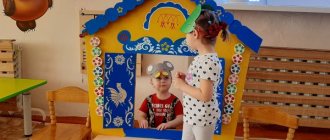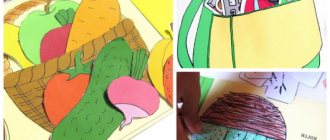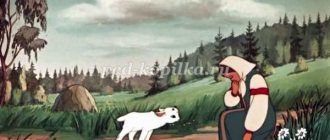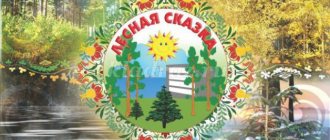MAGAZINE Preschooler.RF
Summary of a lesson on speech development in the senior group Topic: learning to write fairy tales Title: “Book of fairy tales”Program content:
1. Learning tasks:
Connected speech:
- teach children to compose a fairy tale according to the “model-scheme for composing fairy tales” ;
- tell a fictional tale consistently and coherently;
- learn to come up with a title for a fairy tale.
Dictionary:
- teach children to select adjectives for nouns (description of characters);
- consolidate the ability to use figurative expressions characteristic of fairy tales in speech.
Grammar:
- practice children in constructing sentences;
Sound culture of speech: learn to convey intonation the characteristic features of fairy tale characters.
2. Developmental tasks:
- develop children’s ability to work with conventional substitutes for fairy tale characters.
3. Educational tasks:
- cultivate interest in fairy tales and their writing
- foster a desire to collectively compose a fairy tale
- develop listening skills.
Material: audio recording “Sounds of the Forest” ; wood and writing on it; direction indicator; flowers with petals (3 pcs.); book of fairy tales; screen; tasks printed on sheets; model diagram for composing a fairy tale; blank A4 sheets with frames (for drawing up an outline of a fairy tale); conditional substitutes for fairy tale characters; markers; glue.
Methods and techniques: questions to children, modeling, encouraging answers, encouragement.
Preliminary work: reading fairy tales; acquaintance with the “model-scheme for composing a fairy tale” ; conducting exercises and games.
Progress of the lesson:
1. – Guys, an extraordinary journey awaits us today. You and I will go to a fairy forest. To do this you need to close your eyes and say:
"Tili-tili-tili-mes,
Open up the fairy forest!”
(we say the magic words, open our eyes, “Sounds of the Forest” - the noise of trees)
- Children, here we are in a fairy forest. Everything about it is unusual and magical. Can you hear the trees rustling?
- Guys, what is that on the tree? (I draw the children’s attention to the inscription on the tree).
— Someone wrote something: “Urgently, urgently help
Find a book of fairy tales!”
Forest inhabitants.
- Guys, we need our help. Will we help the inhabitants of this forest find the book?
2. - Look, the road direction sign: if you go left, you will be lost; If you go to the right, you will fall into a hole; If you go straight, you will find a book of fairy tales.
-Where should we guys go? (directly)
— There’s some kind of note: “Stop! Walk now wait!
A meadow of flowers is in front of you! Every flower has an enchanted animal. Guess it and describe it. One petal - one description.
What animal is this? When you answer, the petal will open. If you open the petals of all the flowers, then you will pass through the clearing
And you’ll end up in a book of fairy tales!”
(children guess enchanted animals by color; flowers have 5 petals; children name adjectives one by one that correspond to this animal).
- Well done! We walked with you through the clearing to the book of fairy tales. But where is she? Here's a note:
“To see a book of fairy tales, you need to guess riddles, And not just guess them, But also show them!”
(children solve riddles and pretend to be animals)
Puzzles:
“What kind of forest animal is this? Stood up like a post under a pine tree And stands among the grass – Ears larger than head.” (Hare)
“Who in the cold winter wanders around angry and hungry?” (Wolf)
- Well done! And here is a book of fairy tales! Do you want to open it? Then we quietly sit on the chairs (the children sit on the chairs opposite the board).
- Are we opening? (open a book that has no pages)
- Guys, the book is empty. Someone tore out all the pages. What to do? How are we going to give it to the fabulous residents?
- Children, you and I can write a fairy tale. Our fairy tale will live in this book of fairy tales. Shall we try?
— Our “model-scheme for composing a fairy tale” . Let's remember and consider the model diagram for composing a fairy tale (read, consider the model diagram).
— Look at the cover of the book. Who were the tales about here?
- Which of these characters will be the main character in our fairy tale?
-Which of these stand-in figures looks like him?
— Describe what our hero looked like?
-What was his character like?
-What did he like to do?
- Let's start a fairy tale. How do fairy tales usually begin? (I glue a circle of the corresponding color into the first frame)
— Then we look at the diagram, what happened? Where and why did our hero go? (the second frame depicts the hero’s conventional substitute and the scene of action)
- What happened next? Describe who he met there? Which of these stand-in figures looks like him? (in the third frame there is an image of the conditional deputies of the two heroes)
- What were they talking about?
- Look at the diagram, what happened then? Where did they go? (in the fourth frame there is an image of heroes and places)
- How will our fairy tale end?
- Well done, we created a fairy tale with you! What should we call it?
- In order for our fairy tale to live in a book of fairy tales, we need to tell it, our diagrams will help us with this. Who wants to tell a story? (a child is called in to tell a story he has composed according to the diagrams)
- Well done boys! The inhabitants of this forest will be delighted with the book of fairy tales and our fairy tale (sheets with a diagram of the fairy tale are placed in the book of fairy tales). You and I will be able to give the fairy-tale residents many more fairy tales that we will compose later. And now it's time for us. Come on guys, let's put the book near the tree. We are returning to kindergarten. To do this you need to close your eyes and say:
“Close the doors of the fairytale forest
Let us go to kindergarten!”
3. – Here we are in the group. Did you enjoy our trip?
— What was the most interesting thing for you?
— What was the most difficult thing?
- What is the easiest thing?
| Next > |



